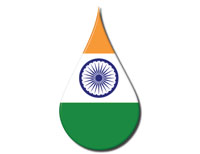Accounting for approximately 8% of the global finished lubricant demand, Africa and the Middle East is a region ripe for growth. The region is forecast to grow at a modest compound annual growth rate (CAGR) of 3% until 2019. Infrastructure and a modernizing vehicle parc will play a role in altering the landscape for finished lubricants in the region.
Nigeria
 Due to the lack of power generation, transmission and distribution system, piracy, and antiquated technology, Nigeria is classified as a generator-powered economy. Therefore, lubricants used in electric generators lead the demand for finished products with an estimated 39% of the total demand. Almost every house, corporate office, and medium to small business in areas across country operates at least one generator to provide electricity.
Due to the lack of power generation, transmission and distribution system, piracy, and antiquated technology, Nigeria is classified as a generator-powered economy. Therefore, lubricants used in electric generators lead the demand for finished products with an estimated 39% of the total demand. Almost every house, corporate office, and medium to small business in areas across country operates at least one generator to provide electricity.
An estimated 45% of Nigerians use petrol-fueled generators ranging from 0-2 Kva due to its cheap maintenance and low fuel consumption. Middle class families and small businesses use petrol-fueled generators ranging from 0-5 Kva with a combined annual consumption of about 106.0 kilotonnes of lubricants. As a result, demand for mono-grade or motorcycle oils will see a positive correlation to the implementation of petrol-fueled generators.
Although Nigeria is one of the largest finished lubricant consumers in continental Africa, finished lubricants are undoubtedly handcuffed by the potential demand loss when a more sustainable and modern energy source is implemented.
South Africa
 In 2014, total demand for finished lubricants in South Africa is estimated at 361 kilotonnes. Industrial lubricants constitute the largest proportion of the demand for lubricants, at 45% of the total. Demand for commercial and consumer automotive lubricants is estimated at 32% and 23%, respectively. Demand for finished lubricants dwindled in the industrial lubricants segment from 2013 to 2014, while experiencing stagnant growth in the commercial and consumer segments.
In 2014, total demand for finished lubricants in South Africa is estimated at 361 kilotonnes. Industrial lubricants constitute the largest proportion of the demand for lubricants, at 45% of the total. Demand for commercial and consumer automotive lubricants is estimated at 32% and 23%, respectively. Demand for finished lubricants dwindled in the industrial lubricants segment from 2013 to 2014, while experiencing stagnant growth in the commercial and consumer segments.
A number of factors contribute to the stagnant and shrinking growth of the market. Labor unrest and electricity disruptions in the mining and manufacturing sectors affected the industrial lubricants segment, with ancillary effects on the commercial and consumer segments. Weakened global demand for commodities further impacts this primarily commodity‐exporting economy, leading to a general slowdown in economic activity and a consequent reduction in disposable income and vehicle sales.
However, the output by South African lubricant manufacturers is rarely affected by the slowdown in domestic demand, mainly due to exports of domestically-produced goods to the rest of Africa, particularly sub-Saharan Africa. South Africa is a hub that supplies the rest of Africa. Thus, the robust growth of 4.8% in the rest of sub-Saharan Africa positively influences the demand for lubricants, particularly for the commercial and consumer automotive lubricants segments.
Egypt
 Egypt constitutes one of the largest lubricant markets in the African continent. ExxonMobil is the leading supplier of finished lubricants in the country, controlling over one-fourth of the market share. Domestic brands are also strong in Egypt; however, consumers are brand conscious and have gravitated towards the use of branded product from suppliers such as ExxonMobil and Shell.
Egypt constitutes one of the largest lubricant markets in the African continent. ExxonMobil is the leading supplier of finished lubricants in the country, controlling over one-fourth of the market share. Domestic brands are also strong in Egypt; however, consumers are brand conscious and have gravitated towards the use of branded product from suppliers such as ExxonMobil and Shell.
There is a large population of commercial automotive vehicles in Egypt; moreover, given the price sensitivity of those in the segment, conventional HDMO maintains a large portion of the market. Furthermore, pricing has caused the consumer segment to have a similar dependency on conventional oil; albeit, smaller in volume. Nonetheless, for synthetics to flourish in Egypt there needs to be economic growth and a modernizing fleet of vehicles for the consumer and commercial automotive segments.
Although both segments are expecting a CAGR between 1% and 3% in finished lubricant demand, the shift towards synthetics will be more prevalent in the consumer segment. The modernizing vehicle parc, government regulations, and initiatives such as the Clean Technology Fund, which seeks to modernize public transport in an effort to reduce carbon emissions, will also boost demand for synthetics in Egypt. However, the proliferation of synthetics will be far less apparent in the commercial space.
Find out what else is occurring in these aforementioned markets and other markets in the region, such as Saudi Arabia, the United Arab Emirates, and Turkey, by viewing the Africa and the Middle East regional fact sheet.

